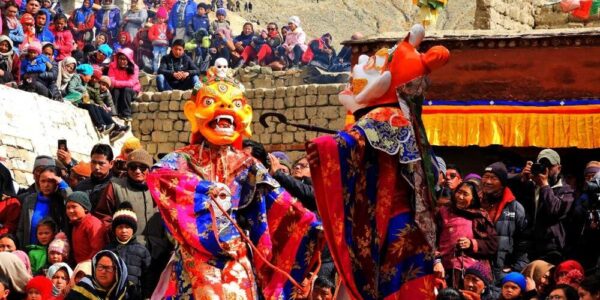Diversity and cultural fests of Ladakh
Ladakh, a region renowned for its vibrant cultural heritage, celebrates a plethora of festivals throughout the year. These festivals are deeply rooted in the religious and cultural traditions of the predominantly Buddhist and Muslim population of the region. Each festival holds its own significance, ranging from commemorating religious events to marking the changing seasons. Here are some of the most prominent cultural festivals celebrated in Ladakh.
Hemis Festival: The Hemis Festival, held in the Hemis Monastery, is one of the most famous and grandest festivals in Ladakh. Celebrated on the tenth day of the Tibetan lunar month, it honors Guru Padmasambhava, the founder of Tantric Buddhism in Tibet. The highlight of the festival is the sacred Cham dance performed by the lamas, accompanied by traditional music and masked performances.
Losar (Tibetan New Year): Losar marks the beginning of the Tibetan New Year and is celebrated with great enthusiasm in Ladakh. It usually falls in February or March and involves rituals for prosperity and the purification of negative energies from the past year. Families gather to exchange gifts, offer prayers, and participate in traditional dance and music.
* Click to Follow Voice of Ladakh on WhatsApp *
Dosmoche Festival: Dosmoche, also known as the “Festival of Scapegoat,” is celebrated in Leh and other monasteries across Ladakh. It is held in February and involves the burning of an effigy symbolizing evil spirits to bring prosperity and good fortune for the coming year. The festival also features masked dances, music, and cultural performances.
Sindhu Darshan Festival: Organized along the banks of the Indus River in Leh, the Sindhu Darshan Festival celebrates the unity in diversity of India. Held in June, it attracts visitors from across the country and showcases cultural performances, music, art exhibitions, and traditional sports.
Ladakh Festival: The Ladakh Festival, held in September, is a colorful extravaganza that celebrates the rich cultural diversity of the region. Organized by the Jammu and Kashmir Tourism Department, it features traditional dance performances, music, archery competitions, polo matches, and handicraft exhibitions. The festival provides a glimpse into Ladakh’s vibrant heritage and attracts tourists from around the world.
Tsechu Festival: Tsechu is a religious festival celebrated in various monasteries across Ladakh, including Lamayuru and Thiksey. It commemorates Guru Rinpoche’s victory over evil spirits and is marked by masked dances, prayers, and rituals performed by the monks. Tsechu festivals are held throughout the year in different monasteries, offering locals and visitors the opportunity to witness traditional religious ceremonies.
Yuru Kabgyat: Yuru Kabgyat, celebrated in the Lamayuru Monastery, is a two-day festival that combines religious rituals with colorful masked dances. It usually takes place in July and involves the performance of sacred dances symbolizing the triumph of good over evil. The festival attracts pilgrims and tourists alike, seeking spiritual blessings and cultural experiences.
These festivals not only showcase Ladakh’s rich cultural heritage but also provide a platform for communities to come together, celebrate shared traditions, and reinforce their cultural identity in an ever-changing world.
5 Comments
Leave a Reply

Would love to be part of the events
U gave me a trip to Ladakh in festivals
Nicely written with good info
Nice. Well documented. It appears except peak winter rest of the year has some or other way for get-together, joy and celebration. Thanks to power cuts.
Besides dance & music wearing mask is common as understand from your article. What may be the reason..? Next driving off negativity..? But now it’s time for celebration as June approaching. Wish to visit and enjoy.wish more to know.
Absolutely Mam. Your presence as an eminent historian will add more stars to its credit. You are most welcome Mam.